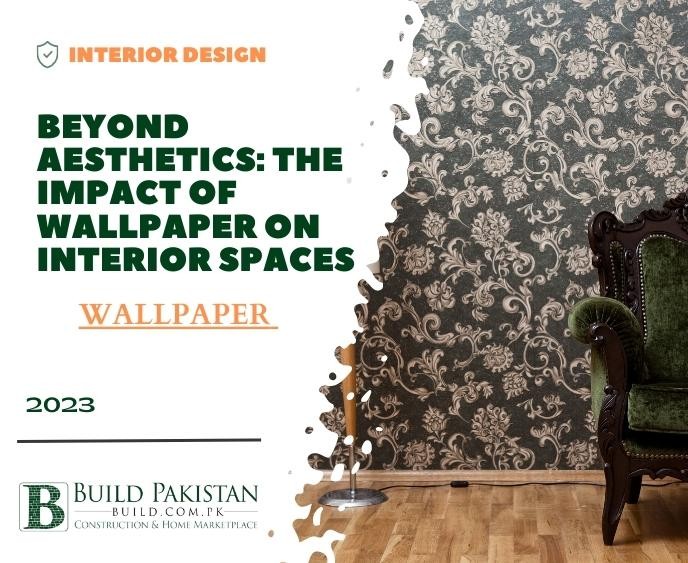Beyond Aesthetics: The Impact of Wallpaper on Interior Spaces

Introduction:
Your house's walls are like a canvas just begging to be painted with your creativity and flair. Wallpaper has become a popular and adaptable medium for giving your living spaces personality and charm. In this article, we examine a handpicked selection of eye-catching wallpaper design concepts that may revitalize any space while expressing your personal style and fostering an environment that appeals to your particular tastes.
The Psychology of Wallpaper:
Wallpaper is a tool that may affect emotions and perceptions in addition to being a visual aspect. Different shapes, colors, and patterns can arouse various emotions. For instance, tranquil wallpaper in soft tones may make bedrooms seem peaceful, while vivacious designs can make living spaces feel lively. Homeowners are more equipped to design interiors that correspond with the intended emotional reactions when they understand the psychology underlying wallpaper selection.

Discussion on Types
1. Nature's Retreat:
Decorate your walls with wallpaper that features peaceful landscapes, lush woods, or beautiful beach views to embrace the peace and quiet of nature. Any space may become a tranquil retreat with this design, inspiring a feeling of renewal and tranquility.
2. Geometric Elegance:
The refined and timeless look provided by geometric patterns. Choose wallpapers with complex geometric patterns that offer depth and a contemporary touch to your rooms.
3. Vintage Charm:
By selecting wallpapers with antique themes, such as traditional damasks, elaborate Victorian patterns, and Art Deco-inspired patterns, you may evoke the nostalgia of bygone periods. Your home will have an air of refinement and history with this look.
4. Artistic Expressions:
Choose wallpapers with creative interpretations, abstract color splashes, or painterly strokes to transform your walls into a painting. This pattern adds a touch of creative flair and sparks conversation.
5. Tropical Escape:
The refined and timeless look provided by geometric patterns. Choose wallpapers with complex geometric patterns that offer depth and a contemporary touch to your rooms.
6. Minimalist Delight:
By selecting wallpapers with antique themes, such as traditional damasks, elaborate Victorian patterns, and Art Deco-inspired patterns, you may evoke the nostalgia of bygone periods. Your home will have an air of refinement and history with this look.
7. Industrial Chic:
Choose wallpapers with creative interpretations, abstract color splashes, or painterly strokes to transform your walls into a painting. This pattern adds a touch of creative flair and sparks conversation.
8. Whimsical Fantasy:
Choose wallpapers that breathe life into dream for kid's rooms or areas where creativity knows no limitations. Consider fantasy creatures, castles from fairy tales, or even space travel.
9. Glamour and Glitz:
Wallpapers with metallic highlights, elaborate patterns, and ornate motifs may provide a hint of richness. This design cultivates an opulent ambiance that goes well with formal dining rooms or master bedrooms.
10. Textured Luxe:
By selecting wallpapers with textured surfaces like embossed patterns or imitation textiles, you may improve the tactile sensation in your space. Your walls get depth and dimension thanks to these patterns.
Practical Benefits of Wallpaper
Beyond aesthetics, wallpaper has a number of useful advantages that improve a room's functionality:
Camouflaging Imperfections:
Textured wallpapers can hide small wall flaws, preventing the need for major wall repairs.
Acoustic Enhancement:
Some wallpapers have sound-absorbing properties, making them perfect for home theaters or loud areas.
Insulation and Energy Efficiency:
Some wall coverings provide thermal insulation, which lowers heat transmission through walls and improves energy efficiency.
Easy Maintenance:
Many contemporary wallpapers are made to be washable and long-lasting, ensuring that they keep their beauty and vibrancy for years.
Conclusion:
Wallpaper is more than just a design decision; it tells a narrative, uplifts the atmosphere, and serves as a blank canvas on which to paint a picture of a place and its occupants. The effects of wallpaper go beyond aesthetics and include psychological, emotional, and practical effects. Wallpaper has the ability to transform interior spaces into individualized, practical, and harmonious sanctuaries, whether it's inducing tranquillity, defining a room's dimensions, or boosting energy efficiency. It exemplifies how innovation, artistry, and pragmatism coexist together in the field of design.









